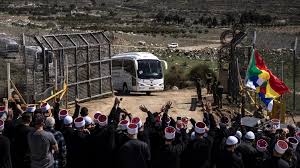Israel Permits Syrian Druze Religious Delegation to Visit Tomb of Prophet Shuʿayb
By Kardo Roj
SUWAYDA, Syria (North Press) – In an unprecedented move reflecting delicate religious diplomacy, Israeli authorities have granted permission for a large delegation of Syrian Druze clerics to enter northern Israel on Friday to participate in the annual religious pilgrimage to the tomb of Prophet Shuʿayb in the Lower Galilee. The decision comes just over a month after a smaller Syrian Druze delegation made a historic visit to Israel, the first of its kind in nearly five decades.
The latest visit is expected to involve around 600 Druze clerics and community leaders from Syria, including approximately 170 individuals from the southern governorate of Suwayda, long considered the heartland of Syria’s Druze population. According to local reports, this will be the first occasion where visiting clerics are permitted to stay overnight in Israel, unlike the previous visit which was limited to a temporary daytime entry.
The trip is centered around the annual celebration at the tomb of Prophet Shuʿayb, a sacred figure in the Druze faith, located near the town of Hittin in northern Israel. The pilgrimage is a major religious event for Druze communities in Israel and the broader region, often attended by spiritual leaders and dignitaries.
The delegation is expected to meet with Sheikh Mowafaq Tarif, the spiritual leader of the Druze community in Israel, who hosted the previous group of Syrian visitors in mid-March. That earlier delegation of roughly sixty clerics was escorted by Israeli military vehicles through the occupied Golan Heights into Israel, where they held meetings and participated in religious observances.
Israeli Defense Minister Israel Katz approved the latest visit following requests from community intermediaries and regional Druze leaders, according to multiple Arabic and Israeli media outlets. The move has been interpreted by observers as both a gesture of religious accommodation and a soft form of cultural diplomacy aimed at bolstering ties with the Druze community across the Syrian-Israeli divide.
The visit has sparked mixed reactions within Syria. While many in the Druze community see it as a rare opportunity to reconnect with religious heritage and family ties disrupted by borders and conflict, others have voiced concern over the broader political implications of such normalization gestures with a country that remains technically at war with Syria.
In Suwayda, reactions have remained largely muted, with community leaders emphasizing the spiritual nature of the journey. Sources close to the organizing clerics said the visit was coordinated independently of Syrian state institutions, focusing solely on religious observance.
For Israel, the move may serve as a symbolic extension of goodwill toward the Druze minority, a community that serves prominently in the Israeli security and civil sectors. For Syrian Druze, it offers a limited but meaningful chance to engage with fellow believers and sacred sites across a frontier that has long represented both political estrangement and shared cultural memory.
The symbolic significance of such a visit is not lost on analysts of the region. With the Syrian conflict entering its fifteenth year, opportunities for cross-border cultural or religious exchange remain exceedingly rare. This pilgrimage, while rooted in tradition, highlights the nuanced space religious identity occupies within the geopolitical tapestry of the Levant.
While the visit is unlikely to signal any broader political thaw between Syria and Israel, it does underscore the enduring nature of cultural and religious ties that transcend militarized borders. The event also points to a broader trend of localized, community-driven diplomacy that quietly persists despite official hostilities.
As the visiting clerics prepare to participate in the Prophet Shuʿayb celebrations, attention will turn to how such symbolic exchanges might shape future dialogue—both within the Druze community and in the broader regional landscape marked by fragmentation and shifting alliances.

